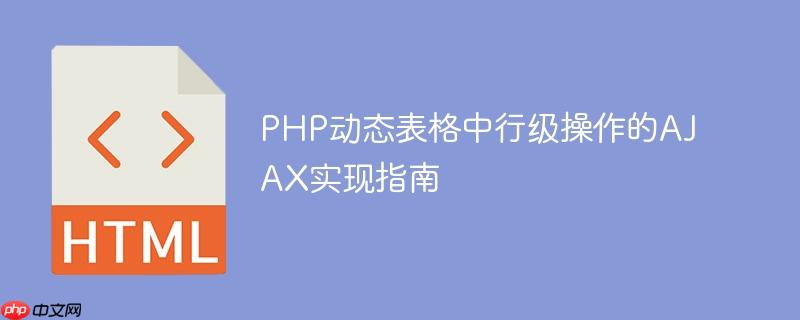
在web开发中,初学者常有一个误解,认为可以在php生成html页面时,通过$_post['variable_name'] = 'value';的方式来“定义”一个post变量,期望在表单提交后,这个变量能被后端接收。然而,这种做法是错误的。$_post是一个超全局变量,它用于存储http post请求中从客户端发送到服务器的数据。这意味着$_post变量是在服务器接收到http post请求时由php自动填充的,而不是在页面生成阶段可以手动赋值并在后续请求中自动保留的。
原始代码中尝试在PHP循环内为每个表单手动设置$_POST['request_id'],但这并不会影响到用户点击按钮后实际发送的HTTP请求。当用户点击提交按钮时,浏览器会根据<form>标签的定义,收集其中所有具name属性的输入字段的值,并将其作为POST请求体发送。手动在服务器端设置$_POST变量,在表单实际提交时是无效的。
为了实现动态表格中行级按钮的精确控制和数据提交,同时提供更流畅的用户体验,推荐使用AJAX技术。通过JavaScript监听按钮点击事件,并异步发送数据到后端,可以避免页面刷新,并根据后端响应动态更新页面内容。
首先,我们需要优化HTML结构,移除不必要的<form>标签,并利用HTML5的data-*属性来存储额外信息,例如按钮的类型。
原始HTML结构(问题代码片段):
立即学习“PHP免费学习笔记(深入)”;
<?php for ($j = 0; $j < count($requests); $j++): ?>
<tr id=' <?php echo $requests[$j]['request_id'] ?>' class="table-row">
<?php if ($requests[$j]['request_type'] == '1') {
$request_type = 'candidate';
} else {
$request_type = 'voter';
} ?>
<form method="POST" action="../assets/php/accept-requests.inc.php">
<?php $_POST['request_id'] = $requests[$j]['request_id'];?> <!-- 错误做法 -->
<td class="school"><?=$request_type?></td>
<td class="name"><?=$requests[$j]['first_name']?></td>
<td class="candidates"><?=$requests[$j]['last_name']?></td>
<td> <button id="acceptReq" name="acceptReq" value="req_accepted" type="submit" class="btn btn-success">Accept</button> </td>
<td> <button id="denyReq" name="denyReq"value="req_denied" type="submit" class="btn btn-danger">Deny</button> </td>
</form>
</tr>
<?php endfor; ?>优化后的HTML结构: 我们将每个请求的ID存储在<tr>元素的id属性中,并通过按钮的data-type属性来区分是“接受”还是“拒绝”操作。这样,JavaScript就能方便地获取这些信息。
<?php for ($j = 0; $j < count($requests); $j++): ?>
<tr id='<?php echo $requests[$j]['request_id']; ?>' class="table-row">
<?php
if ($requests[$j]['request_type'] == '1') {
$request_type = 'candidate';
} else {
$request_type = 'voter';
}
?>
<td class="school"><?=$request_type?></td>
<td class="name"><?=$requests[$j]['first_name']?></td>
<td class="candidates"><?=$requests[$j]['last_name']?></td>
<td> <button data-type='accept' name="actionButton" value="req_accepted" type="button" class="btn btn-success">Accept</button> </td>
<td> <button data-type='deny' name="actionButton" value="req_denied" type="button" class="btn btn-danger">Deny</button> </td>
</tr>
<?php endfor; ?>注意:
我们将使用JavaScript的fetch API来发送异步请求。fetch API提供了一种现代、强大的方式来处理网络请求。
// 创建一个 FormData 对象,用于构建POST请求体
// 注意:如果在循环中创建并发送请求,每次请求都应创建新的 FormData 对象,
// 或者在每次设置参数前清空,以避免数据混淆。
// 这里为了简化示例,使用一个全局fd,但在实际应用中,建议在事件监听器内部创建。
let fd = new FormData();
document.querySelectorAll('button[name="actionButton"]').forEach(bttn => bttn.addEventListener('click', function(e) {
// 阻止按钮的默认行为(如果按钮类型是submit,但我们已改为button,此行可选)
e.preventDefault();
// 获取当前点击按钮的父级<tr>元素
let tr = this.parentNode.closest('tr');
// 从<tr>的id属性获取请求ID
const requestId = tr.id.trim(); // 使用trim()去除可能存在的空格
// 从按钮的data-type属性获取操作类型
const actionType = this.dataset.type;
// 清空并设置FormData对象
// 每次点击时都重新设置,确保发送的是当前按钮的数据
fd = new FormData(); // 每次点击都创建新的FormData对象
fd.set('id', requestId);
fd.set('type', actionType);
// 使用fetch API发送POST请求
fetch('../assets/php/accept-requests.inc.php', {
method: 'post', // 指定请求方法为POST
body: fd // 将FormData对象作为请求体发送
})
.then(response => {
// 检查HTTP响应状态码
if (!response.ok) {
throw new Error(`HTTP error! status: ${response.status}`);
}
return response.text(); // 解析响应体为文本
})
.then(text => {
// 请求成功后的回调函数
alert('服务器响应: ' + text);
// 在此处可以根据服务器响应更新DOM,例如移除已处理的行
// tr.remove(); // 示例:如果请求成功,移除当前行
})
.catch(error => {
// 请求失败或网络错误时的回调函数
console.error('请求失败:', error);
alert('操作失败,请重试。');
});
}));在../assets/php/accept-requests.inc.php文件中,你可以通过$_POST超全局变量接收到id和type参数,并根据这些信息执行相应的数据库操作。
<?php
// accept-requests.inc.php
if ($_SERVER['REQUEST_METHOD'] === 'POST') {
// 检查并清理接收到的数据
$requestId = filter_input(INPUT_POST, 'id', FILTER_SANITIZE_NUMBER_INT);
$actionType = filter_input(INPUT_POST, 'type', FILTER_SANITIZE_STRING);
// 确保数据有效
if ($requestId && ($actionType === 'accept' || $actionType === 'deny')) {
// 连接数据库(请根据实际情况替换数据库连接代码)
$servername = "localhost";
$username = "username";
$password = "password";
$dbname = "myDB";
try {
$conn = new PDO("mysql:host=$servername;dbname=$dbname", $username, $password);
$conn->setAttribute(PDO::ATTR_ERRMODE, PDO::ERRMODE_EXCEPTION);
// 根据actionType执行不同的数据库操作
if ($actionType === 'accept') {
// 执行接受请求的逻辑,例如更新请求状态或移动到另一个表
$stmt = $conn->prepare("UPDATE requests SET status = 'accepted' WHERE request_id = :id");
$stmt->bindParam(':id', $requestId, PDO::PARAM_INT);
$stmt->execute();
echo "请求 {$requestId} 已接受。";
} elseif ($actionType === 'deny') {
// 执行拒绝请求的逻辑,例如删除请求
$stmt = $conn->prepare("DELETE FROM requests WHERE request_id = :id");
$stmt->bindParam(':id', $requestId, PDO::PARAM_INT);
$stmt->execute();
echo "请求 {$requestId} 已拒绝并删除。";
}
} catch (PDOException $e) {
http_response_code(500); // 设置HTTP状态码为500表示服务器内部错误
echo "数据库操作失败: " . $e->getMessage();
} finally {
$conn = null; // 关闭数据库连接
}
} else {
http_response_code(400); // 设置HTTP状态码为400表示客户端请求错误
echo "无效的请求参数。";
}
} else {
http_response_code(405); // 设置HTTP状态码为405表示方法不允许
echo "只允许POST请求。";
}
?>重要提示:
虽然不是功能核心,但提供一些基础CSS样式可以显著提升用户体验和界面的可读性。
* {
transition: ease-in-out all 100ms;
font-family: monospace;
}
th {
background: rgba(50, 50, 100, 0.5);
color: white;
}
tr {
margin: 0.25rem;
}
tr:hover td {
background: rgba(0, 200, 0, 0.25);
}
td,
th {
margin: 0.25rem;
border: 1px dotted rgba(0, 0, 0, 0.3);
padding: 0.45rem;
}
button:hover {
cursor: pointer;
}
[data-type='accept']:hover {
background: lime;
}
[data-type='deny']:hover {
background: red;
color: white;
}将上述PHP生成的HTML、JavaScript和CSS结合起来,可以得到一个功能完整的示例。
<!DOCTYPE html>
<html lang="zh-CN">
<head>
<meta charset="UTF-8">
<meta name="viewport" content="width=device-width, initial-scale=1.0">
<title>请求管理面板</title>
<style>
/* 这里放置上面提供的CSS样式 */
* {
transition: ease-in-out all 100ms;
font-family: monospace;
}
th {
background: rgba(50, 50, 100, 0.5);
color: white;
}
tr {
margin: 0.25rem;
}
tr:hover td {
background: rgba(0, 200, 0, 0.25);
}
td,
th {
margin: 0.25rem;
border: 1px dotted rgba(0, 0, 0, 0.3);
padding: 0.45rem
}
button:hover {
cursor: pointer;
}
[data-type='accept']:hover {
background: lime
}
[data-type='deny']:hover {
background: red;
color: white;
}
</style>
</head>
<body>
<table>
<thead>
<tr>
<th>请求类型</th>
<th>名</th>
<th>姓</th>
<th colspan="2">操作</th>
</tr>
</thead>
<tbody>
<!-- PHP循环生成的行数据 -->
<!-- 假设 $requests 数组包含以下结构的数据:
$requests = [
['request_id' => 1, 'request_type' => '1', 'first_name' => 'Geronimo', 'last_name' => 'Bogtrotter'],
['request_id' => 2, 'request_type' => '1', 'first_name' => 'Horatio', 'last_name' => 'Nelson'],
['request_id' => 3, 'request_type' => '0', 'first_name' => 'John', 'last_name' => 'Smith'],
];
-->
<?php
// 模拟数据,实际应用中从数据库获取
$requests = [
['request_id' => 1, 'request_type' => '1', 'first_name' => 'Geronimo', 'last_name' => 'Bogtrotter'],
['request_id' => 2, 'request_type' => '1', 'first_name' => 'Horatio', 'last_name' => 'Nelson'],
['request_id' => 3, 'request_type' => '0', 'first_name' => 'John', 'last_name' => 'Smith'],
];
for ($j = 0; $j < count($requests); $j++):
$request_type_display = ($requests[$j]['request_type'] == '1') ? 'candidate' : 'voter';
?>
<tr id='<?php echo $requests[$j]['request_id']; ?>' class="table-row">
<td class="school"><?=$request_type_display?></td>
<td class="name"><?=$requests[$j]['first_name']?></td>
<td class="candidates"><?=$requests[$j]['last_name']?></td>
<td> <button data-type='accept' name="actionButton" value="req_accepted" type="button" class="btn btn-success">Accept</button> </td>
<td> <button data-type='deny' name="actionButton" value="req_denied" type="button" class="btn btn-danger">Deny</button> </td>
</tr>
<?php endfor; ?>
</tbody>
</table>
<script>
// 这里放置上面提供的JavaScript代码
let fd; // 声明fd,但每次点击时重新创建
document.querySelectorAll('button[name="actionButton"]').forEach(bttn => bttn.addEventListener('click', function(e) {
e.preventDefault();
let tr = this.parentNode.closest('tr');
const requestId = tr.id.trim();
const actionType = this.dataset.type;
fd = new FormData();
fd.set('id', requestId);
fd.set('type', actionType);
fetch('../assets/php/accept-requests.inc.php', {
method: 'post',
body: fd
})
.then(response => {
if (!response.ok) {
throw new Error(`HTTP error! status: ${response.status}`);
}
return response.text();
})
.then(text => {
alert('服务器响应: ' + text);
// 根据实际需求更新UI,例如移除行
// tr.remove();
})
.catch(error => {
console.error('请求失败:', error);
alert('操作失败,请重试。');
});
}));
</script>
</body>
</html>通过采用AJAX方法,我们不仅解决了PHP中$_POST变量的误用问题,还大大提升了应用程序的用户体验和响应速度。这种模式是现代Web开发中处理动态数据和交互的推荐方式。
以上就是PHP动态表格中行级操作的AJAX实现指南的详细内容,更多请关注php中文网其它相关文章!

PHP怎么学习?PHP怎么入门?PHP在哪学?PHP怎么学才快?不用担心,这里为大家提供了PHP速学教程(入门到精通),有需要的小伙伴保存下载就能学习啦!

Copyright 2014-2025 https://www.php.cn/ All Rights Reserved | php.cn | 湘ICP备2023035733号